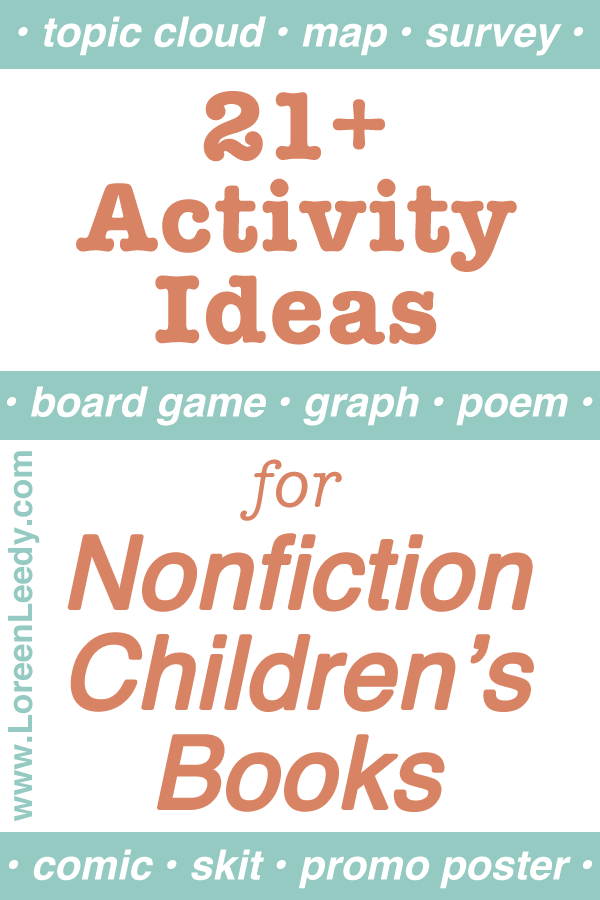Parents, teachers, librarians, and children’s book authors have the same goal, to inspire kids to become good readers for academic and career success as well as lifelong enjoyment. It's vital for students to master informational texts according to the education learning goals set forth in the Common Core State Standards and similar guides.
Students must be familiar with a number of concepts to effectively read and write informational text.
Providing quality resources to young readers is a great way to start. Nonfiction books for kids have come a long way from the traditional style that included just the facts plus some photographs. A wide variety of attractively designed titles are available including narrative nonfiction, image-laden books that are great for browsing, and “active” nonfiction that teaches the skills to make or do something. For a helpful guide to 5 overall categories of nonfiction books, please see the posts about The Nonfiction Family tree on children’s author Melissa Stewart’s blog, such as this article.
How are book-based activities useful?
Reader engagement is increased by activities that help students think deeply about and work with the text, images, vocabulary, diagrams, and other content in the book. Writing, drama, art, and other creative projects require multiple learning styles and brain pathways, and help make the information much more memorable. Let's explore some options!
Blog post: 21+ activity ideas for nonfiction children's books
Introducing the book
Make it as simple or involved as you prefer. Sometimes it's fine to jump right into reading a book with little advance preparation and go with the flow. Here are some additional approaches to try:
• Preview a book’s content ahead of time to get kids thinking about it. For example, to introduce the topic of my book Step by Step, show a photograph of animal tracks and invite guesses about which animal made them.
• Read a page or two aloud with students and ask for predictions about what the rest of the book will contain. Take a survey to see what students believe about the topic.
• Students can complete a KWL chart to record what they Know before reading the book, what they Wonder about while reading, and what they Learn from it.
• Older students can choose a book to read on their own then create a project based on its content. Suggest a few ideas such as the ones listed below to help them get started.
• Read a fictional story that relates to the nonfiction book’s content.
Record the content
During or after reading, make a list, mind map, or topic cloud of the subject matter, themes, and curriculum connections for the book. The image below lists the topics in Step by Step.
Inspiration for creation
Brainstorm activities that will allow students to think carefully about, research, write, and create using the book's content. Some may require advance prep by the teacher. Below are several examples that work for many nonfiction books, depending on the age level.
• Scavenger hunt inside the book for vocabulary words, facts, and/or pictures
• Coloring pages, a craft, diorama, mobile, drawing, or painting
• Diagram with labels
• Write a song, chant, or poem
• Book review in a unique form such as comic book style
• A new front cover design
• Sequencing cards to put events in order
• Illustrate and describe a step-by-step process
• A follow-up slide presentation about the content
• Poster to summarize or promote the book
• Mini-book or class book inspired by the topic
• A chart or map of the information
• A board game, illustrated glossary, skit, or bulletin board display
• Think of a food tie-in such as this example of animal tracks snack ideas
Putting it all together
Round up some materials, help the kids start planning, and let the creating begin! The activities will vary depending on the book, student level, and time available. And based on my experience, kids find book-inspired projects challenging, enjoyable, and very memorable.
Hopefully this article has given you some fresh ideas for nonfiction book extensions to help your students get more out reading informational texts. If you would enjoy more posts about children's books, classroom activities, educational resources, and freebies >>> please subscribe on the blog sidebar. Thanks so much for coming by!
Happy reading,
Loreen Leedy
Children's author-illustrator
Instagram: @loreenleedybooks
Pinterest: @LoreenLeedy
Facebook: @authorLoreenLeedy
21+ Activity Ideas for Nonfiction Children's Books




